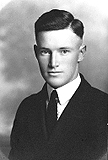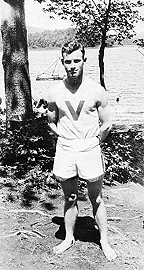

| SEARCH |
| UVM A TO Z |
| WHITE PAGES |
| UVM HOME |
 Dan Dyer greets you at the door of his St. Johnsbury home with
a handshake and a smile. Come around back, he says, nobody comes
in the front door except for funerals and weddings.
Dan Dyer greets you at the door of his St. Johnsbury home with
a handshake and a smile. Come around back, he says, nobody comes
in the front door except for funerals and weddings.
Dyer makes a pretty good advertisement for being one hundred years old. He is quick to take you upstairs to show off photos of the rifle corps or the track team from his days at UVM, and he’ll continue standing even while Catherine, his wife, quietly encourages him to take a seat.
Dyer was born November 3, 1900 in New York City. “Can’t you tell by my accent?” he asks, his words clipped and clearly Vermonter. Though, he was indeed, born in New York, Dyer was just three years old when his father moved the family to a farm in Albany, Vermont.
One of eight children, Dyer would be the only one in his family to attend college. It took some nudging to get him there, he admits. His mother and the principal at Craftsbury Academy encouraged him to go to high school. And his father urged him to continue his education rather than enlisting to fight in World War I. Agriculture and education were Dyer’s focus during his undergraduate years, and it was as a teacher, principal, and superintendent that Dyer would make his career. His life in Vermont’s schools spanned forty-two years and a number of the state’s communities from Craftsbury to Essex Junction to St. Johnsbury.
 The hundreds of birthday cards in neat stacks on the piano in
the Dyers’ home are testament to the relationships built over
those years with students, teachers, and parents. “It was a big
job,” Dyer reflects. “As I look back, the more I realize that
there is a lot more to teaching than subject matter. It is dealing
with people and encouraging them. You can hurt people or you can
move them along.”
The hundreds of birthday cards in neat stacks on the piano in
the Dyers’ home are testament to the relationships built over
those years with students, teachers, and parents. “It was a big
job,” Dyer reflects. “As I look back, the more I realize that
there is a lot more to teaching than subject matter. It is dealing
with people and encouraging them. You can hurt people or you can
move them along.”
Among the constants in Dyer’s life have been family and friends, his work, a love of travel, and a deep loyalty and affection for his years at the University of Vermont. His time on the UVM campus, now some eighty years in the past, remains a vivid and important time in Dyer’s life.
And when UVM alumni return for Reunion 2001 at the end of May, Dan and Catherine Dyer say you can be expecting them. VQ
Let me take you back…
— Excerpted from Dan Dyer’s speech to classmates at his 50th reunion
in 1974.
The speech was reprinted in its entirely on the cover of UVM’s
alumni magazine of the era.
Let me take you back to September 23, 1920 when 312 young men and women came upon this beautiful campus to enroll in the class of 1924. Most of them came by train, steam train that is. There were no airports, no bus lines, and few if any students had automobiles. In fact very few freshmen knew how to drive an automobile in 1920. So over the railways they came and when they arrived at the station the last lap of the journey for some was on the trolley cars.
We came to UVM at the beginning of the “Roaring Twenties.” There was no energy crisis, no student unrest, no coed dorms, no learning and living center, no teacher unions, no long-haired men. However, in deference to the Rudolph Valentino fad of that time, some of the fellows wore their hair combed back and plastered down with slickum.
It was the heyday of the Greek Fraternity. College spirit ran high. Attendance at games, smokers and rallies was a must. And woe to the freshmen who broke the rules.
The college years were joyfully long: mid-September through mid-June. There were no long winter recesses, no mid-May graduations, no five-day weeks, no four-day weeks. Classes were scheduled for six days a week and on the seventh you studied. And when we graduated it was the 23rd of June.
During the ’20s the back campus was of a pastoral nature. It was a place where the girls played field hockey in their natty middy blouses and baggy bloomers; where inter-fraternity and inter-class games were played, and where Col. Holden’s army drilled. A little easterward from that area and in close proximity to the then primeval forest of murmuring pines rose stately Converse Hall, UVM’s only men’s dormitory — a place where a college lad got excellent rooming accommodations for the $80 for the college year. Also nearby stood a one-story wooden structure — Commons Hall, dubbed the Hashhouse, a place where a student got his three squares a day for a total of $1; seven days a week, Sunday through Saturday for a total of $7. With a tuition rate of $175 in-state and out-of-state, think of the bargain we got. We received so much and gave so little.